I wish I could go back and change the past, but I can’t, so this is where we stand. At least we have memories.
All photos and editing herein by Richard X. Thripp, Aug-Dec 2008.
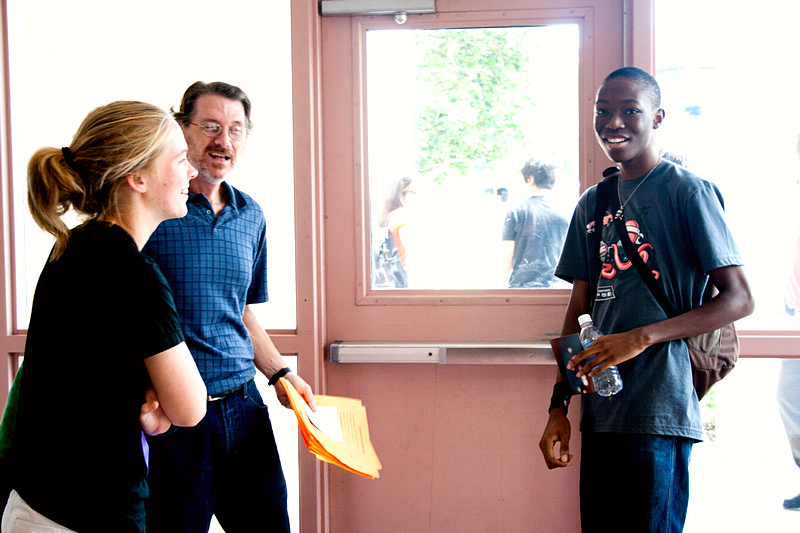

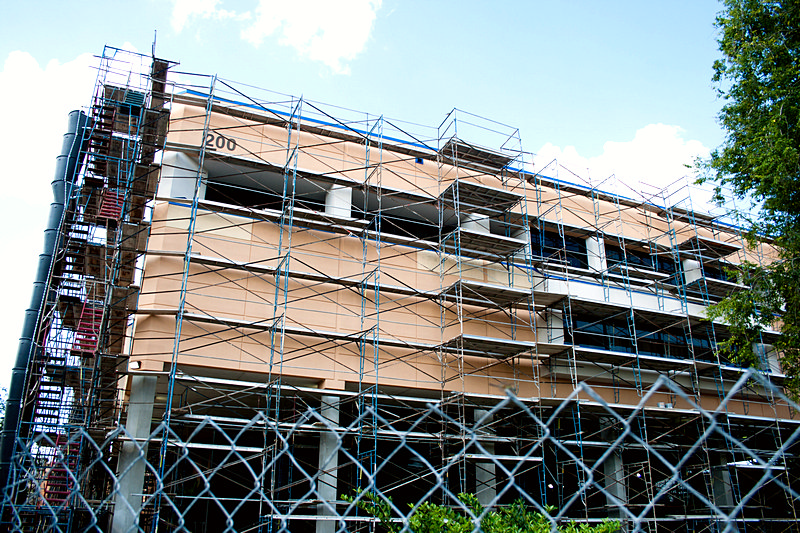
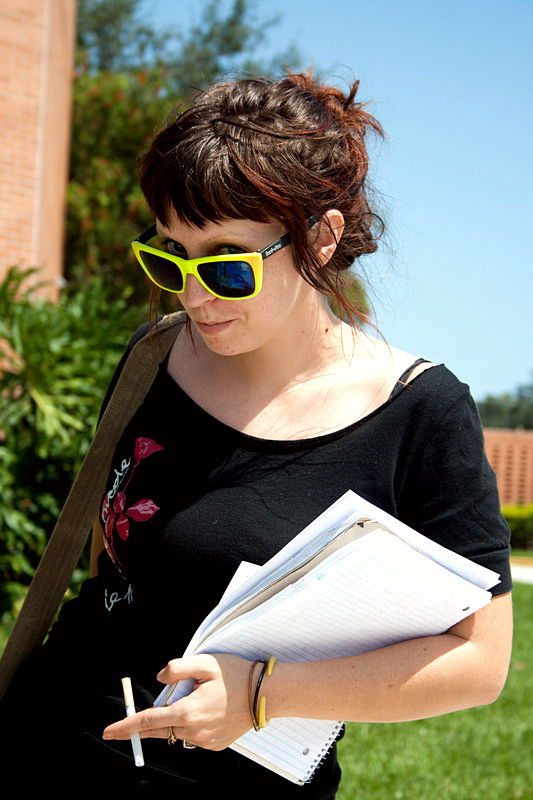
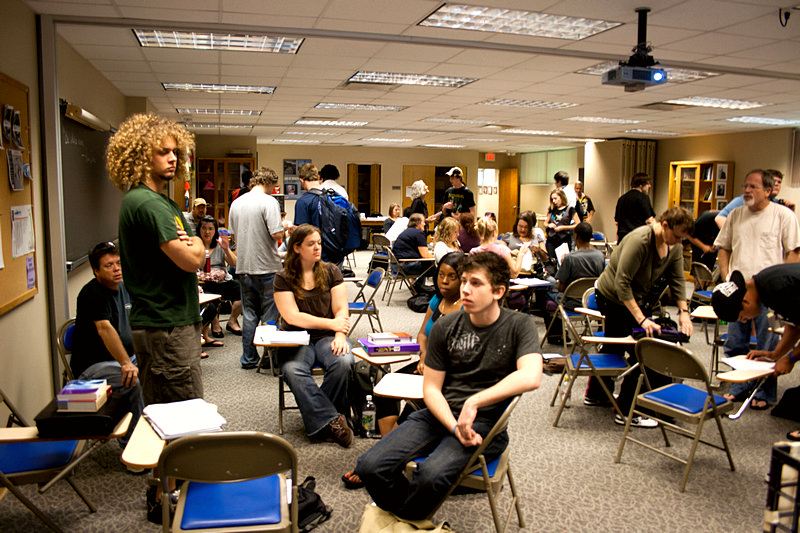

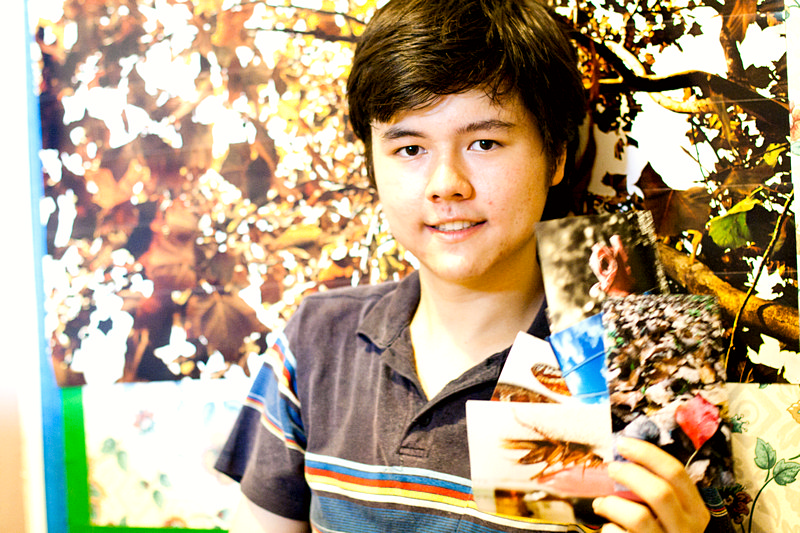

I wish I could go back and change the past, but I can’t, so this is where we stand. At least we have memories.
All photos and editing herein by Richard X. Thripp, Aug-Dec 2008.







This is a portfolio of twenty of my best photos. Since I feel my best work is from 2005, 2006, 2007, and 2008, this portfolio contains photos from those years only.
*****

July 9, 2006: Ketchup

January 8, 2007: Assimilation

October 22, 2006: Sunrays

January 18, 2007: Rose of Orange

July 7, 2006: Yellow Grasshopper

August 19, 2007: Yellow Sunshine

February 26, 2008: The Red-Brick House

August 31, 2007: Leafy Sunset 6

August 23, 2007: The Garden in Yellow

October 10, 2007: Implicity

March 9, 2011: Leafy Droplets 4

June 28, 2006: Leafy Droplets

June 17, 2006: Sky’s Camouflage

February 22, 2006: Blue Marbles

November 11, 2007: Complicity

April 15, 2007: Simplicity

June 11, 2006: Pink and Purple Sunset 3

January 5, 2008: Two of Us Against the World

May 9, 2008: Liquid Suspension

June 13, 2006: Raindrops
*****
I’m going to start doing a series of “behind the photo” articles in summer 2011 detailing the methodology behind the composition, editing, and presentation of select photos. If you would like to vote for a particular photo for me to prioritize, say so in a comment on this blog post or the associated blog post for said photo. 
This morning at 03:15 Eastern Standard Time we had a complete lunar eclipse, the first one on the winter solstice since 1638. The next one on a winter solstice will be on 2094-12-21, exactly 84 years from now. However, I did not find this eclipse much different from the ones I saw as a young child. The moon looked darker and less red than I remember, but it might be that I used to have better eyesight. We were lucky to have no cloud cover in Ormond Beach, Florida, and despite having only a 28-135mm lens on my Canon Rebel XTi I snapped a few pictures which aren’t very good, but are significant for me. I really need to invest in a tripod since it was hard to hand-hold for these. 3900×2600 became 238×238 pixels after cropping.



The photo below is at f/1.4, ISO 1600, 3.2″ exposure with my Canon EF 50mm f/1.4 lens when the moon was fully eclipsed. Normally, the moon would be so bright it would overpower the stars, but in the photo below you can see all the stars clearly (high-res version).

I don’t look up at the stars much, but I enjoyed this. Someday when we are mining the moon for Helium-3 to power our intergalactic spaceships, we will look back on the 2010 lunar eclipse as a memory of simpler and more oily times.

On 2009-09-30 I shot some studio portraits for my friend Anita Cohen at Daytona State College, of her pregnant daughter Jacquelyn and her daughter’s husband Shaughn. Even though I’ve been a photographer since I was 13 (5 years), this was my first time working formally. Thanks to Prof. Joe Vance for letting me use the photography studio at Daytona State College even though I’m not in the photography program (I’m a computer science student).
Jacquelyn is due to have Shaughn Brady Jr. at the beginning of Nov. 2009. Sadly, Shaughn has to return to Iraq for his second tour in Apr. 2010, so he’ll miss his son’s growth from the age of five months to over a year. Here, he is wearing his camouflaged U.S. Army uniform. He’s a driver rather than front-line infantry. I hope he stays safe and doesn’t have to kill anyone.
We had a white background. Anita helped me figure out how to set up the hot lights and deflectors. I used one incandescent light (warm a.k.a. yellowish) on the left and one fluorescent light (cool a.k.a. bluish) on the right, which worked well. While some maternity photographers exaggerate the size of the woman’s belly or emphasize deep, brooding poses, I did not do that here. I prefer realistic, upbeat portraits showing love and joy.

Shaughn kissing his wife’s belly. I wasn’t sure about Jacquelyn’s facial expression, but I think Shaughn’s outfit balances the discipline of the army with the love he has for his wife and first son.

The only portrait of Jacquelyn and Shaughn I used the flash on. This is a conventional rather than artistic portrait, but portraiture is about the people in the portraits, and not necessarily innovation of the medium.
Shaughn is covering a red birthmark above Jacquelyn’s belly button. On the first portrait I edited it out, but on the second it was easier to leave it. I like to remove most blemishes to make people look how they’re supposed to look. My goal is to discreetly present an idealized version of reality. I don’t want laymen to say “this is Photoshopped!” Photographers will always say it, but non-photographers should not notice. However, depending on the angle and lighting in can be hard to clone out blemishes, so I have to balance art vs. time. I don’t air-brush; I either remove blemishes well or I don’t remove them at all. In my portfolio I have done difficult edits requiring hours of work (i.e. removing twigs, power lines, and houses), but elsewhere I re-shoot or leave it.

Our couple standing together, with Jacquelyn showing her tattoo saying “Shaughn” in cursive with a Hibiscus flower. The tattoo is for her husband and her son. I like it.

Anita (Jacquelyn’s Mom) calls this the “Marilyn Monroe” shot, in the style of an actress from the 1940s and ’50s famous for poses like this. For all the portraits, Anita wrapped the green sheet around Jacquelyn. Underneath Jacquelyn had a blue bathing suit on. Unfortunately that came through here (on her hip), but we didn’t notice it at the time. It’s not a big deal.
I shot all these portraits using my Canon Rebel XTi with my EF 50mm F1.4 prime lens in RAW mode. I edited in Adobe Camera RAW 5.0 (vignetting and color) and Adobe Photoshop CS4 (spot-editing), which is industry standard. I brightened the photos and made the colors warmer by shifting to a white balance with a higher Kelvin temperature, because I used automatic white balance in camera which was too blue.
Incidentally, a Daytona State College photography student asked to shoot Shaughn while he was in the lobby, but Anita shouted out “he’s already taken!” 
Big thanks to Anita for making a $100 donation to my photography fund. I opened a checking account recently and deposited it there. I will use it for whatever photography or non-photography purchases I need to make in the next months, or bills.
I give well wishes and lots of love to Anita, Jacquelyn, and Shaughn, and I want the United States to leave Iraq, Afghanistan, and every other country we occupy, as soon as possible, never to return. 
Personal development is universal, so it includes photographers. A lot of photographers are stuck in a lot of ways. They take too many photos, entangle their intuition with technicalities, refuse to rise above spectatorship, or abandon their creativity for the comfort of rigid rules. I did all these for some time, so I want to help others rise above these limitations.
Most photographers live with a scarcity mindset. This means they believe they must be taking photos every moment, in case they miss the ‘perfect’ moment. There is only one ‘perfect’ moment (scarcity), so it’s important not to miss it.
I can tell you this because I used to be one of these people, and I meet fellow photographers who are stuck in the same mindset all the time.
Back when I was in photography class, I met a lady who took 1500 pictures of a wedding in a span of two hours. I’ve been fortunate enough to avoid weddings, but I can tell you now that I would be taking 1500 photos, even if the wedding was all day. I might take 1000, but I can assure you they’d mostly be duplicates. I’d be deleting the worst and keeping the best on the spot, and by the end of the day I’d be down to 200 photos. Good photos.
What was even more unfortunate about this girl was that she made no effort to cull her work. “Culling” means picking out the best. I slaved for hours over my portfolio, narrowing down hundreds of photos to my best 30. Some good photos didn’t make it because they just didn’t fit in with the other ones. I spent more time ordering them by color / concept than choosing, because the order is far more important than the content.
It’s alright if you take 1500 photos for a wedding, even if you keep them. But when you do that, know that you’re going to bore the heck out of people by showing them all, and you’re going to put in many hours weeding out the crud.
If you don’t weed out the weeds, you’ve got nothing. All people will see is a bunch of weeds and they’ll walk away before you get to the good stuff.
Ironically it’s the abundance mindset that leads you to taking fewer pictures. Your work becomes much more interesting too, because you’ll produce a few great pieces instead of dozens of mediocre ones. Oftentimes you’ll actually take more photos, but they’ll be focused. Instead of doing 50 shots of every plant in the garden, do 200 of a rose from every possible perspective. Learn from it, pick out the best one (I do mean one), and discard (hide) the rest.
For photographers, the abundance mindset says that you’ll have so many great photo opportunities, it’s alright not to pursue them all. It’s even alright to ignore a beautiful sunset just to focus your camera on the light on the trees. If you’re in the scarcity mindset, you’re dead-set on the sunset because you’re afraid you’ll never see one like it again. But really, what you get is the same dull photo that everyone else has already taken, while you could’ve been using the sunset for something better, like portraits of passersby (the lighting is great), refractions off a leaf, the clouds behind you, or the light and shadows around you.
The abundance mindset lets you focus on one thing while ignoring everything else. If the space shuttle is launching right in front of you, take pictures of all the people taking pictures instead of the shuttle itself. Take a photo of the launch site ten seconds after lift-off. No one is doing that.
Believing in abundance lets you go for a walk in a “boring” neighborhood yet bring home a picture like this:
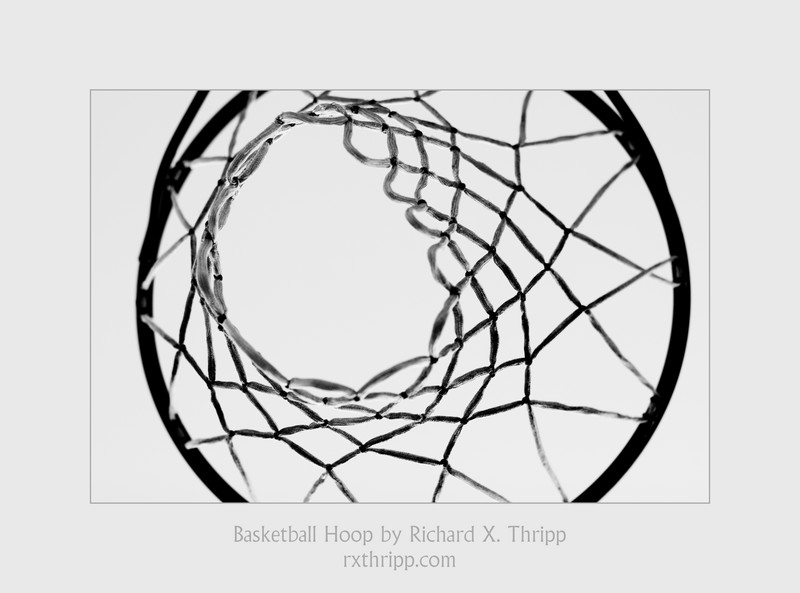
Whatever you think is ‘boring’ isn’t so boring after all. I hear photographers complain all the time that there is nothing interesting around them, but really they aren’t even trying.
If you’re not willing to look harder for subjects (still life or people) in your current environment, go somewhere else. Go to different places, talk to different people, take different pictures. Go on vacation. Become a nomad. It isn’t that hard, and if you believe it is you’re only limiting yourself.
Other photographers believe they should be hands-off. “Just take pictures, don’t interfere with people or nature.” Photograph what you see. Really, what these people are doing is trying to absolve themselves from effort. They’re scared of directing people on how to pose, so they’d prefer just to leave it up to their models.
But the fact is, your models don’t know what to do. As the photographer, it’s YOUR job to tell them what to do. The word “photography” implies mere observation, but it’s so much more than that. As a photographer, you create the scene. Even if you don’t have to tear down buildings or dirty your hands with makeup, you do have to direct people and the environment. Even if you don’t touch anything, you’re still directing the scene through composition. You can get far away and use a telephoto lens, or close-up with a wide-angle lens, and you’ll get two very different photos of the same subject under the same light. You can take photos at eye level, or you can lay in the dirt and point your camera up. You can include things, you can exclude things, you can manipulate light, all without entering Photoshop.
Any wedding actually involves three people: a man, a woman, and a photographer. It’s really a marriage of three. You have to tell the couple how to pose, where to stand, what to wear; perhaps even what day to plan their wedding for or where to hold it. If it’s a Florida summer, retreat indoors. People like sunshine, but cloudy days make for better lighting. These are all going to be important if you want to create good memories, because memories are about emotion, not facts or record-keeping.
I used to have this unstoppable urge to stretch the histogram across the gamut from light to dark in every photo. This means I’d edit contrast fairly aggressively, and then whatever was left over I’d leave up to the computer’s “Auto Contrast” tool. Every picture should touch (0,0,0) (pure black) and (255,255,255) (pure white) in at least one pixel.
This worked fairly well for a while. I did cool stuff like Raindrops and Sky’s Camouflage. Even Two of Us Against the World, which most people think of as soft-toned, is stretched across the whole gamut.
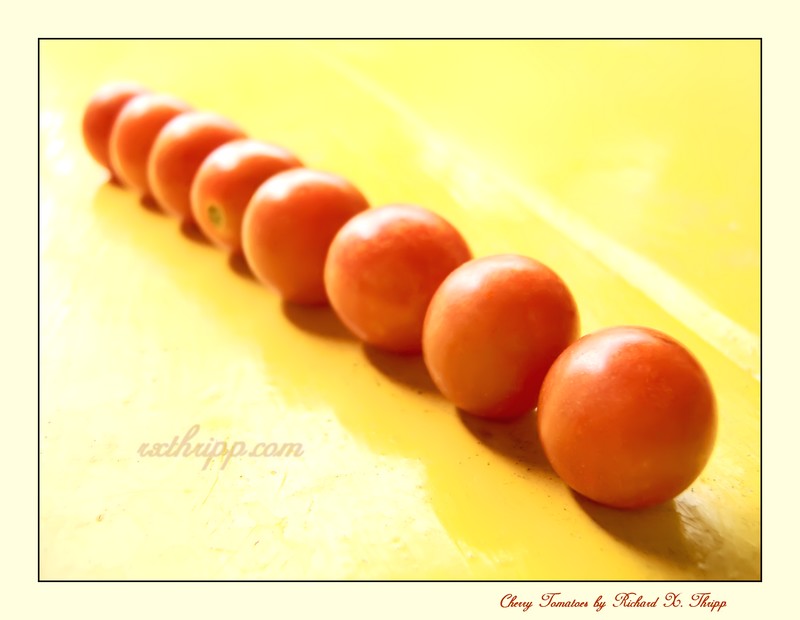
This became very limiting, though. When I got to pictures like Cherry Tomatoes (above), it couldn’t look good with the tomatoes going to black, but that’s the only decision that would keep in step with my beliefs. I compromised on that one; the darkest tone is about (110,20,0), with 90% of the colors being in the upper fourth of the luminance scale. This way, I could continue criticizing other photographers (in my mind) whenever I’d see anything with dull contrast.
It turns out, dull contrast is often good. Going back to the basketball hoop photo, if I would’ve done what I used to do, the sky would be right up against pure white. But with subdued colors, it’s much more appealing and interesting (the sky doesn’t go past 230/255).
What this means is: be flexible. No rules are hard and fast, and everything can look good in different occasions. Don’t use rules or formulas to determine that; use your eyes and your innate sense of beauty. Which brings us to…
Psychologists say women like mental pictures, men like real pictures. This (supposibly) is because men are left-brained while women are right-brained. This means that “visual learners” fall into the left-brained category.
For 90% of photographers this is false. Unless you’re in technical or journalistic photography, you’re going to be dealing with the right-brain (emotions) most of the time. This falls under of the umbrella of artistic photography—most people just call this photography, because it’s what the medium has become associated with.
But even if you’re a photo-journalist, a big portion of your time (if you’re good) will be about emphasizing emotion. If there’s no emotion, create it. You can ‘cheat’ without editing the image. Use a different angle, or convince the people in the scene to act differently, consciously or subconsciously.
The purpose of my photographs is to create emotions within my audience. It doesn’t matter if the pictures are true. It doesn’t matter if I tore up weeds or if I used a medicine dropper to add droplets to a leaf. It doesn’t matter if I completely Photoshopped the colors so they look nothing like the actual scene. It doesn’t even matter if the scene is a physical impossibility.
What matters is creating feelings within my viewers, be it affection, love, awe, repulsion, emptiness, bravery, coziness, timelessness, intrigue, courage, freedom, oneness, or inspiration. While I may not identify it as such, each photo has one main emotion behind it, and sometimes a second one, which either complements the first or contrasts with it in an ironic way. This isn’t something you can purposely manufacture; I never even thought about it this way till I wrote this paragraph. It’s just there.
This means that photography falls on the right side of the brain. Emotions are more important than logic.

The sunset above doesn’t exist. The sky had the same colors and appearance, but it was much less brilliant. I emphasized the colors in Photoshop. You might be able to do the same thing with a polarizing filter or settings in-camera, but you’d always be creating something better than reality.
Most people, seeing this photo, either revise their model of reality to include the existence of sunsets like this (90%), or ask me if I manipulated the photo (10%). The last group I tell yes, so they can appreciate this sunset while knowing it isn’t ‘real’ (whatever that means).
If you act ashamed that you edit your photos a lot, your viewers will assume it’s a shameful thing. Don’t do that. I removed trees, houses, and streetlights in the sunset above, not because I wanted to, but because I had to. I’d always prefer just to take a new photo than to spot-edit an old photo, but this one was worth it.
Most of the time I do editing across the whole photo, like contrast, brightness, and color temperature. I’ll do localized dodging and burning (brightening and darkening), but I try to avoid spot editing, not for ethical concerns, but because I’m lazy. Spot editing is hard, and if I have to spot-edit a photo to take out power lines or trees, I may as well start over with a new photo.
This picture makes no sense:
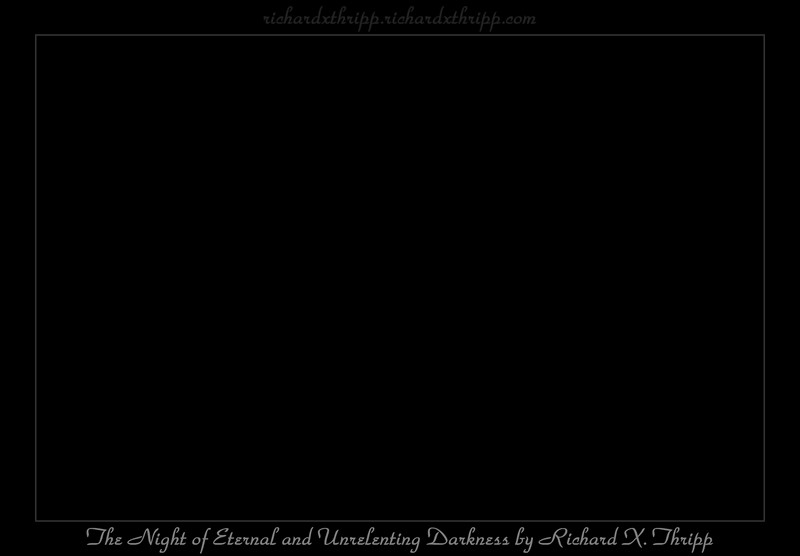
People love this when they see it, and even more so when I give out print copies. They’ll try to interpret all kinds of meanings into a solid black image, and just discussing it raises their personal awareness. Obviously it’s a picture of nothing (I left the lens cap on) but because I’ve gone through the effort (and possibly cost) of printing it, titling it (The Night of Eternal and Unrelenting Darkness), and giving it to someone, it must have meaning.
I’m actually having 100 printed out (I get them through thievery so it’s no big deal), one for each of my students in calculus and biology, and I bet it will be my most popular (at least most talked about) photo. The reason is that it’s insanely interesting. Nobody else does stuff like this (much less handing them out). If I posted to Facebook or deviantART or YouTube, it would probably be removed as pointless ‘spam’, merely because such originality scares the deletionists.
To be insanely interesting, you should create something from nothing. If everyone did this, it wouldn’t be interesting. Most people are very uncomfortable with this. They want to create something from something. This is because most people have a subconscious desire to be directed / told what to do. Personal development is all about flipping that on its head.
What happens to a lot of students when they get into photography school? They start worrying about things like the golden triangle, film speed, the zone system, apertures, focal length, vignetting, the rule of thirds, sharpness, filters, white balance, color temperature, optical distortion, color calibration, sensor size, chromatic and spherical aberration, file formats, resolution, signal-to-noise ratio, refraction, demosaicing. The beautiful photographs on their walls are replaced by crazy formulas like (1 / f) = (n – 1) * ( (1 / R1) – (1 / R2) + ( ( (n – 1) * d) / (n * R1 * R2 ) ). They went to college because they had a talent for artistic photographs, but that talent totally disappears when they get there. They fail miserably. Grades are irrelevant; you’re failing with A’s if you’ve lost your heart.
Why does this happen? Because people naturally want to replace personal responsibility with assignments and directions. Instead of creating beautiful photographs, you create photographs that are beautiful according to other people, because you want to be told what to do. That’s why you went to school to begin with. No one forced you. Plenty of great photographers have never set foot in a school of photography.
I remember when the colors on my computer monitor started drifting, and my edits wouldn’t turn out right in any prints. They’d be close, but not perfect, and I couldn’t get the thing calibrated by eye because my eyes aren’t good enough. I took a whole month off searching for a cheap colorimeter and a dual-head video card to use with my new LCD monitor (which, incidentally, is no good for photo editing; I keep all editing to my bulky CRT). I did find one eventually, but I would’ve been better off working on new photos too, even if I had to go back over and re-edit them. When you get too caught up in technicalities, you produce no art. Technicality is all about perfection, but if you make perfection the goal, you’ll never get anywhere. You have to balance analysis with creativity.
Overly technical people get caught up in the things that ‘should’ look beautiful but simply don’t. Take a look at this rose:

Doesn’t it look nice, sublimely colorful, etc.? If a pink rose is pretty, an even pinker rose must be prettier, right? In fact, following the technical mindset to the extreme, beauty is proportional to color saturation. So this rose must be ten times more beautiful:

Of course, it’s terribly ugly. A flower doesn’t become more beautiful when you dye its petals—in fact, it loses its beauty post-haste. But you’ll see stuff like the above in photographers’ portfolios. Usually, they’re either really new to photography, or they’ve been doing it for a long time but stagnating in technicalities.
The proper response to analytical photography is not analytical photography with intuition and creativity tacked on. It’s creatively intuitive photograph, tempered by technical analysis. That means that yes, it’s alright to purposely put your subject one-third into the frame (I do it all the time), but just don’t become too extreme regarding technicalities. When you break the rules, don’t even think about it. They’re not rules anyway.
You do have to be technical to a certain extent. You can’t leave everything up to chance, or put all your faith in your “eye” without learning a certain amount of technical concepts (exposure, f-stops, zooming, composition, shutter speed, grain, etc.). A great photo is no good badly exposed and printed.
Particularly in film photography, there is a lot of technical grunt work you must deal with by hand. You don’t want to use any old developer or fixer, and you should use a timer, a timing chart, measure the temperature of your chemicals, etc., because if you mess things up, you could end up with nothing, especially if any light gets to your negatives before you develop the latent images. Once you’re done with this process, enlarging the images isn’t so dangerous, but light-sensitive paper is still expensive, so a mistake might cost you 70 cents.
I prefer to just stick with digital photography. You have as much control in film photography, but you don’t have an “undo” button, and I can’t get by without that (yet). It’s like writing in pencil vs. writing in pen. Except digital cameras are a bit better than pencils.
It’s okay to collect cameras, lenses, gadgets, and relics. But only if you’re going to use them to advance your photography hobby. If you’re not, be sure they’re really cheap, because a bunch of lenses do nothing for you if you can’t find the shutter button.
A lot of self-dubbed photographers don’t take pictures so much as they collect picture-taking gadgets. These people think about becoming real photographers occasionally, but then they get stuck in self-doubt.
These are the types of people who will put off photography for years waiting for the technology to get better. Things are getting cheaper all the time; that doesn’t mean you should stay out of digital photography forever. Buy a camera now and take a big ‘loss’ in a few years. It isn’t really a loss anyway, because nothing that lets you work on your art is a loss.
Also, these people will look back at what they did in the past with a cheap camera, wishing they could retro-actively change it to an expensive camera. You can’t go back and do that, and even if you could, you can’t improve by imitating your past work (tell that to Ketchup 2 and Ketchup 3).
Don’t collect gear. Use gear to take photos. Whatever camera you have now is good enough to do something good with. You just need some creativity, not more stuff.
Keep on snapping.

I run into a lot of photography purists, but I don’t believe any of it myself. Photography is nothing but a series of manipulations. You’re manipulating the scene by composing it any differently than a non-photographer. You manipulate the appearance of the scene by zooming in or out. You manipulate your viewers’ outlooks by composing to exclude unsightly objects. Motion blur, shallow depth of field, under or over exposing… these are all creative manipulations on your part. You may not have as much creative control as with painting, but you can still be quite expressive. But creativity isn’t “pure.” If we can define any solid definition for “pure” photography, they’re going to be dull, boring snapshots that no one wants to look at. Don’t do pure photography. Anyone can do pure photography; it takes a real master to do impure photography.
The great thing is, when you embrace impure photography, a whole world of creativity opens to you. Pure photographers are constantly wasting time with ethical debates: is it okay to make the world look purplish in Photoshop, or only through the white balance setting in-camera? Can I crop my photos, or is that misrepresenting the scene? Can I add contrast to a scene that obviously needs it, or do I need to stick to my limiting philosophy? Impure photographers have no such shackles. The “code of ethics” is: do whatever is right to make the photo beautiful. No one cares if you change the white balance. Adding contrast is great. Brightening teeth? Spot-editing blemishes? Sure. It makes people look like they should. It isn’t a question of keeping the image true to the camera sensor; the goal is to produce an image true to the vision in your head. Creative photographs come from people, not computers.
Ironically, as an impure photographer, you’re always making the world look like it’s supposed to. Sunsets are supposed to be beautiful, bright, breath-taking, colorful. Raindrops are supposed to be frozen still, black and white, shiny, and contrasty. And darn it, flowers and people are supposed to be bright and animated with nicely blurred, defocused backgrounds. If you’ve ever debated F1.2 as impure for not showing the world like our eyes see it, you’re really steeped in the dogma. Let it go. You’re on to a grand world of free photography.
In truth, the only way to be a photographer is to be a free photographer. As a creative photographer, your task is to create an idealistic reality that is also a realistic ideal. If that means desaturating backgrounds on roses, removing specks of dirt, and burning in corners, then so be it. If it means adding a glow effect, filters, and sunrays to a sunset, it’s all good. Your tool is your camera, but your real power is your mind. It’s like painting, where you get to pick all the colors for the scene, but without all the heavy lifting. You can create so much more because there’s no need to build everything from scratch. You start out with a solid base (the world), and then you take away or alter the elements that need changing, be it by composition, post-processing, or any other method. As a photographer, you unlock your creative mind and become a more free person, because you’re set free from the grunt work of other artistic mediums and can instead work on the big picture. It’s like moving from assembly code to a high-level programming language.
As a free photographer, you will refuse to support film where digital surpasses it in quality and efficiency. There is no purism; hard work does not contribute to the creative value of a piece. It makes no difference if I took 100 shots of the falling droplets on my digital camera, picked the best, then edited out the ugly bits, rather than wasting 100 expensive frames of film and 15 prints in the darkroom getting my exposure and burning right. Even if I do that with the film, it’s not going to be as good, because I’m not good with film. If you’re not good with film, so what? Use digital then. It’s the wave of the future. The finished product is what counts. If it took you three days in the darkroom or thirty minutes in Photoshop, it makes no difference and each medium is as valid as the other, as long as what you do looks good. Your photos have to be inspiring, beautiful, challenging, creative, and fresh, all at once. That’s what counts.
If you’re in any sort of camera clubs or photography classes, your friends won’t like what I’m writing. They’ll spout some spiel about how photography is a time-honored and labor-intensive craft, and it must remain so. It’s not your job to change or influence the world; you’re just a recorder. If you edit your work, you are cheating your viewers. Your taking away from all the good photographers who put the work in (a.k.a. luck) and create one-tenth the beautiful images because of their fear-based orthodoxy. That’s what you’ll be told. Don’t listen to it. It’s not your friends who are talking. Their true thoughts have been stolen by the prevailing spirit of oppression and negativity. It is not your job to change them. Just go into the world pushing forward with your art, and if you are being a free photographer, other people will take note, because you’ll be producing fantastic work. And they’ll start switching over too. We can start a revolution.
A note on “camera clubs”: don’t join one. I’d never join a camera club. If I want to be with my people, I’ll join a photography club–not a camera club. Just like if I want to read, I’ll join a reading club, not a book club. It’s not so bad with book clubs, though. The unfortunate thing that happens with camera clubs, is that people get caught up in the science of photography and forget about the art. And even then, they’re not focusing on the science so much as their own notions: limit-based notions that keep them from pursuing their art form for want of some technical limitation. But there are no technical limitations. Sure, this is all relative. You can’t do much with a cheap disposable camera, and there are just things our cameras can’t capture, like huge ranges of light or certain shades of purple. But the difference between what our cameras can do, and what the camera club participants pretend they can do is quite vast. If you have a Canon PowerShot A590 or anything like it, you can do anything. Practically anything. In fact, by the time you get near the do anything level, you’ll be four cameras up. It won’t even matter. Start creating your best work now, not ten years from now.
I remember when I started getting serious about my creative photography in 2005, and all I had was a Fujifilm FinePix A360. And there were some things that I just could not take pictures of, or they were really hard to take pictures of. I could never get a good shot of lightning, despite numerous attempts, because I had no control over the ISO speed or shutter speed. With the cheap cameras, many things are automatic-only, like the settings on mine were. I wanted a good shot of falling raindrops, and after much perseverance, I got Raindrops. Unlike with my Canon Rebel XTi and fast lens, the only way to do it with the FinePix A360 was in the bright sunlight, so it had to be raining in the sunshine, but that happened because I kept watching. Then I had the necessary light to freeze the rain in motion.
You’ll run into all sorts of limitations like this in your photography. Perhaps you have the Canon Rebel XTi, and you’re finding the kit lens is too slow for indoor low-light portraits (I did). Or you’re filling up the burst buffer too quickly with your rapid shooting on the football field. The limitations can be anything, but the free photographer’s way is to embrace and work with them, at least till you can afford the expensive gear that attacks them directly. Learn how to be still to avoid camera shake with a bad lens, accept grainier photos with a higher light sensitivity setting, or just take three shots for every one so you’ll be bound to get one right. Switch from RAW to JPEG for quicker burst shooting, or buy a faster memory card to compensate (rather than a faster camera, which is much more expensive). Whatever you do, don’t give up saying that good photography is impossible with your current setup. That’s the coward’s way out.
Free photography, as much as it is about embracing all formats, methods, and editing as equal and valid, it is about not making excuses for anyone but yourself. If you miss the moment when the lightning struck the ground, don’t blame your camera, or your lens, or your lack of a college education. If you can’t produce a beautiful image because your source image needs work and that work isn’t permitted by your oppressive photography religion, don’t accept it as fate. Don’t blame anyone or anything else for shortcomings in your work. Have the courage to accept that anything you’ve failed to do or any photo opportunity you’ve missed is your own fault. The reason you can’t create beautiful photographs isn’t because you never see anything interesting. There are plenty of interesting things in your house, in your yard, and around your neighborhood. Or there are dull things which can become interesting when you shoot them in a new light or from a new angle. The “I never see anything / go anywhere interesting” excuse is your own way to excuse yourself from the guilt of not following your artistic passion. But you can stop it, right now. Instead of saying “there’s nothing interesting,” say “I don’t put enough effort in.” Once you rephrase your thoughts and words to put the keys in your hand, you’ll be on your way to putting more effort in, or making whatever change you need for your art form. It’s the first step. No more excuses.
I’ve used the “I never see anything interesting” excuse myself, once or twice. But if all I’ve written hasn’t appealed to you, I have one more piece of advice. Go somewhere interesting. It’s not that hard. Millions of other people do it every day. Go for a walk, visit the park, climb to the top of some high building. If you’re not seeing interesting subjects, it’s your responsibility to change that. It’s all part of being free and empowered, rather than a slave of fate.
Enjoy your life as a free photographer. You’ve just made a huge step above 99% of the other people in your field. I hope to be with you too.
• Make sure everyone is smiling and pretending to be happy before taking the picture. Candid photography? Never heard of it.
• Don’t take photos of people; they don’t want you to take their photos anyway. Just stick to rocks and plants.
• Make your rocks blurry and your flowers over-exposed. Then claim it’s art.
• Pump up the saturation and contrast on that rose, so it’s just (255,0,0) all over. Then everyone will appreciate the beauty.
• Print your photos, then scan the prints at 600 pixels per inch. Now you have 48 megapixels!
• Never switch from auto mode. Only scary people use aperture priority. Manual mode is for the fully insane.
• Or, switch to manual mode, and refuse to use auto-focus. The camera doesn’t know how to focus. It’s just blocking your artistic vision.
• Always talk about your artistic vision, and the wonderful community of photographers your a part of. Maybe people will start believing it.
• Say a 12 megapixel camera is 20% better than a 10 megapixel camera.
• Buy a $2000 DSLR, then stick a cheap lens on it.
• Set your new $2000 camera down to go to the bathroom. Follow the advice in 10 Ways to Get Your Camera Stolen. Why would anyone want a camera?
• Refuse to use anything but a prime lens. Those zoom lenses are too modern and convenient. They’re not sharp enough either. It’s settled. You’re not a real photographer if you use a zoom lens.
• Constantly talk about “real photographers” versus the non-real photographers that are pervading your art form. Make sure some reference to film vs. digital is included.
• Say that film is useless, because digital is magical and does everything.
• Say that digital is useless, because film is the only true photographic medium.
• Assume you should always keep your camera zoomed out, because whenever you zoom in, you must be losing quality.
• Complain about the scary focal lengths on SLR lenses. 18-55mm? What’s that mean? 3.06x zoom? Why didn’t you just say so?
• Assume that 4x optical zoom is the same for all cameras, and that all cameras have equivalent focal lengths by default. You have no concept of wide-angle or telephoto.
• Keep your new DSLR at 18mm all the time, then wonder why everyone’s so fat and distorted.
• Use big words like barrel distortion, pincushioning, vignetting, chromatic aberration, etc. You have no idea what these mean, but they must make you look smart.
• Refuse to buy a camera that doesn’t use AA batteries.
• Use the flash all the time. If you have beautiful ambient lighting and a fast lens, kill it with a blinding strobe.
• Never use the flash. The flash is evil. Fill flash is eviler.
• Say that digital is no good because all print copies wither and turn green in three months. Chemical prints? For digital? That’s crazy talk.
• Ask if you need a lens to use the camera.
• Print your photos, then DELETE the digital source files. You don’t need them anymore, right?
• Assume anything with “digital” in it must be great. You need a “digital” lens, with which you should use digital “zoom,” because it must be the way to go.
• Keep calling your memory cards “disks” over and over. Windows does it; it must be right.
• Refuse to edit your photos. It’s just not true photography.
• Create a 20-page policy booklet before you snap any photos. You have to stay at 50mm all the time, because that’s most photographic. Certain menus on the camera are off-limits, because they’re too un-photographic. Those menus are: white balance, exposure bias, picture styles, color toning, sharpness and contrast, and several others. You can edit on the computer, but only to make the photo look more like the original scene. Contrast adjustments are okay, but cloning is not. Dodging and burning must be reviewed by a committee.
• RAW beats JPEG. If you use JPEG, you’re an idiot. Make sure to polarize all your friends on this, and then shun the ones who have ever used JPEG.
• JPEG does everything RAW does. The picture quality is identical. You only need RAW if you’re doing lots of editing, but if you need to do that, the photo is no good anyway!
• Plan out a sliding scale of quality settings to save space. 10MP RAW is just for special art photos. 10MP JPEG is for normal shooting, while 5MP JPEG is for birthdays and events (because of the volume of photos). Use the 0.3MP JPEG setting for anything you’ll post online. Heaven forbid you should accidentally shoot a special art photo when you’ve planned for something else.
• Keep no backups of anything. Just one copy of your photos in My Pictures. Or, make a backup copy… on the same hard drive.
• Catalog your photos by giving them descriptive file names. How to give file names to photos is bunk.
• Make eight copies of that photo: one for your flowers folder, one for macros, one for colors/red, etc. Nevermind that you’re wasting 70 megabytes.
• Complain that your DSLR’s LCD screen is broken.
• Complain that new digital cameras immediately become obsolete. I didn’t know they stopped making SD cards and batteries.
• Complain constantly. Be negative all the time. Photography is crap. Print articles like 10 Reasons Photography Sucks and Isn’t an Art Form to prove it to everyone.
• When someone shares his photography with you, ask him if it’s Photoshopped. If he says anything like a yes, shun him. If it’s a no, accuse him of lying, then commence the shunning. We photographers are so good like that.
• Print 4×6 photos on an inkjet. You knew it was coming.
The five chapters in your adventure:
1. an introduction to stock photography
2. taking the photos
3. nitty-gritty editing
4. how to pitch a model release
5. building effective keywords
Stock photography is not art photography. If you’re looking to express your creative spirit while making a comfortable living, this is not the place for you. You can do the latter with work, but not the former, because stock images are boring as salt.
Curiously, the best stock photos are interesting. Crafting a photo that is not boring yet appeals to advertisers is a lot harder than creating a whole bunch of boring photos and making it on volume. I don’t know how to do the interesting, successful ones, but they usually involve people shaking hands or flying kites at the beach. In this article, I’ll be introducing you to the technical details that will help you to create boring stock photos. Then you can move up to better ones later. If you don’t learn these basics, your great ones will look slightly imperfect and won’t sell (read: won’t be accepted by your microstock agency), which we can’t have.
Most people elbowing their way into the stock world start with the microstock networks, because they’re the only shot for an average Joe to make any sort of money. Ones like iStockphoto, Shutterstock, fotolia, and Big Stock Photo. These websites let up upload your photos, which they then sell to their customers, taking much of the profits but giving you a commission (something like twenty-five cents per sale). They’ll only take stuff they think will sell, and only if the image is “perfect”: grain-free and plastic looking, six or more megapixels, no artifacts (if you have a cheap camera, this is impossible), and other requirements. If you’ve tried going out on your own, you know how hard it is to get viewers, let alone customers (I have enough trouble giving my photos way), but you’ll get guaranteed traffic at these sites, just as you’ll get more visitors to your MySpace page than to your Geocities page (sorry for the outdated examples).
In microstock, you have to make it on volume, because you’re giving non-exclusive, royalty-free rights cheaply. The good thing is you have the potential to build a passive income, if people continue to buy your photos after you’ve posted them. If you’re fairly good, you can expect to make a few dollars a year per photo, which will snowball with your tireless work and hundreds of contributions.
Stock agencies are really crazy about noise (a synonym for grain). They’ll reject photos for any sort of grain, even if it’s artistic. DSLRs produce less grain because of their larger sensors, but images, even in broad daylight, will be often be rejected if they’re done on digital compacts, because they have smaller sensors and produce lots of noise all the time.
The best you can do in-camera is to use the lowest ISO speed setting, as this has the lowest light sensitivity and produces the least grain. If your photos are blurry because your shutter speed is too slow, add more spotlights or get a tripod to keep the camera steady.
Enough about noise, onto your subjects. A good subject is people, making business deals, doing things, vacationing with family, surrounded by palm trees, at the beach, pretending to be happy, etc. Too many people focus just on still life, because they’re too shy to scout for models and ask them to sign the necessary forms. It isn’t that hard, though.
Take pictures of your family! You still have to get them to sign forms, but they may be a good start for you to build up your portfolio, and you have access to them all the time. For stock portraits, you want to use a fairly shallow depth-of-field: enough so that all the people are in focus, but not so much that the background is crisp. You can do this by putting your subjects an equal distance from your camera and using an aperture like F2.8, though this won’t work on digital compacts because their smaller sensors permanently put them in wide-depth-of-field. Don’t cut off arms or legs, because those might come in handy later.
While you normally want to keep your images open to manipulation, the best-selling stock images don’t do this at all. Take a look at the top fifty at Shutterstock, and you’ll see flower compositions like this, which will no doubt be dropped right in to advertisements or presentations. I don’t imagine any users will be whiting out the background or warping the perspective on one of the flowers. It also violates the rules by having an artistic rather than practical title, but images sometimes are the most salable. It’s hit and miss to figure out, so start off with the boring stuff and work your way up.
For normal stock images, you want your subject to be sharply in focus with a small aperture, on a solid white or black background, with studio lighting, and with loose cropping. Go rent a studio, or set up a white sheet, a white table, and some spotlights in your bedroom. Then, start taking uncreative yet useful pictures of generic objects like fruits (nice fruits), unidentifiable candies (turn those Skittles upside-down), staplers, thumbtacks, and other colorful objects. Make sure every step along the way you’re using the lowest ISO speed, a high F number (you’ll need bright lights), focusing on your subjects sharply, and leaving enough space around them for your users to crop or add text.
Soon, you can move up to more unusual objects. Then, go out into the world and take uniquely beautiful nature shots. If you have an unusual job, like working in a steel mill, or on a farm, or at the top of the Empire State building, you have an even better place to take valuable stock photos from, because you have a different angle to work with from the start. Stock photography does have a certain creative edge to it, of finding the most valuable image for your customers. Watch for scenes that represent concepts, like solitude, inspiration, or bravery, because if they hit, they’ll be your greatest photos ever.
This is all geared toward Adobe Photoshop. The reason I talk so much about it is because it’s the editing software most people use, including myself. It’s $600, so most people pirate it (you can find it easily with an online search). All this stuff applies to other software too, though.
Many people say you shouldn’t edit your photos; you should let that up to your users, as they’ll want to manipulate the image the way they want, without your intervention. Phooey. You need to edit your photos, to remove grain, imperfections, add color and contrast, and possibly isolate your subject (make everything else white). Your users don’t want to spend two hours fixing your image; you have to do that yourself, even if it alienates a few of them. I could never sell this as a stock image, for example, but the edited version of Simplicity could make money (if it wasn’t free).
You have to do a darn good job at editing, though. I like Noiseware for noise removal; there’s a free version way down at the bottom here, which is still pretty good. You should do your noise removal first, as when you add contrast, the noise gets amplified, and it won’t remove smoothly after a lot of editing. I like to edit destructively, so my workflow is cloning and spot removal -> save a copy -> convert to 16-bit PhotoRGB -> noise removal -> curves and contrast improvements -> save another copy -> save a separate 8-bit JPEG. This means I need to estimate how aggressive I should be with noise removal, before adding the finishing touches. I do this intuitively from years of experience. You can use trial and error till you get it, or figure out how to use masks or layers or whatever the young ones do nowadays.
16-bit PhotoRGB is great because you’ll avoid rounding errors that cause color banding. It takes up lots of space, though. Expect to use 75MB with your two copies of each photo. It doesn’t matter though, because if you take 20,000 photos in a year, you’ll only be doing this for the 500 best ones, and that’s 38GB, which is cheaper than ever to store.
Back to the editing. You need to remove specks of dirt from your roses, or acne and blemishes from your models, or the black specks you know to be birds in your skies, even if you’re fundamentally against it. I do this on all my work, because my goal as a photographer is to present a realistic ideal of the world. This means my photos (should) look perfect, but believably so. You must do the same with your stock work. Use Photoshop’s spot healing brush for blemishes and dirt, but look closely so you’re doing a good job. Zoom in to 400% if you have to. Hit Ctrl + Shift + Z and try again if it turns out ugly, which it often will. If that fails, switch to the clone stamp to copy one part of the image to another. This is more tricky, but you can get it right with practice, by picking an area of similar shape and brightness, Alt + clicking, and then clicking over the bad part. After two years and 1000 photos, this’ll be second nature and you’ll be getting through a photo with hundreds of specks in fifteen minutes flat, and making it look believable.
After you get done in this stage, use the levels tool (Ctrl + L) to brighten and darken the image a lot. You can undo it right afterward. If you’ve done your job well, nothing will look suspicious. But in the beginning, you’ll get bad results all the time. Here’s an example. Say the floating antenna is all the rage now, so you dutifully use your spot healing brush to produce this:
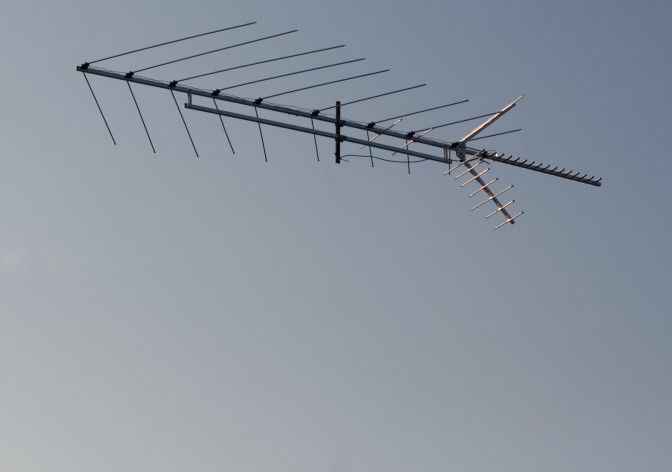
It looks fine, right? You might not even zoom in past 25%, because you’re working on a huge ten megapixel file. Then you add your wonderful contrast, and something seems astray. You might chock it up to your imagination and post your photo anyway, but little did you know the problems you’d created:
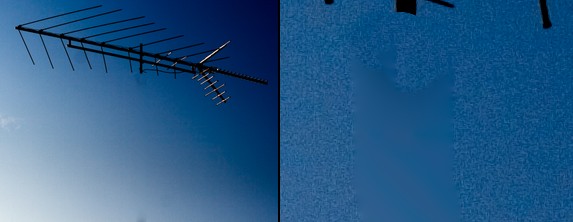
Obviously, I skipped noise reduction here for effect. But nevertheless, this is what will happen if you don’t pay attention. Blue skies are tough to edit. Everyone who tells you you can reshape bodies and clear power lines out of skies easily has no idea what they’re talking about. It’s tough work, especially if you want to get it right.
So at this point, what do you do? Go back and try it again. For blue skies, use the cloning brush with a higher hardness setting; perhaps 90%. You can see the shortcomings of the healing brush right here; it makes everything into a blurry mess, not matching the surroundings. This image has been effectively ruined for stock use. In time, you’ll learn these limitations, and working around them will be a breeze. Even then, try to avoid spot-editing by getting it right in-camera. The floating antenna wasn’t such a hot idea after all.
Even if your image looks fine on your calibrated, CRT monitor, it might look awful on your customers’ overly bright, uncalibrated LCD monitor, because these defects will be revealed. This is the reason to use the levels tool to over and under-expose the image: you can quickly and easily check for the invisible problems you missed.
When you edit for contrast, do whatever it takes to make the image the most appealing to your customers. This will most likely involve contrast adjustments with Curves (Ctrl + M), perhaps with a reduction in saturation (Ctrl + U). If you’re editing in an RGB color space, curves pushes the color channels as far as luminosity, which is not ideal. I’ll often reduce the saturation by 30% before using curves to counter-act this. Activate your histogram (Window > Histogram), and watch all four windows (brightness and the RGB channels). If any of them trail off to the right, you need to scale back because that channel is clipping. When the color clips, there is no detail, because it’s as saturated as it can be. While it can be artsy, for stock work, you must avoid this. The histogram in Photoshop is just as important as the histogram in your camera.
Try Image > Adjustments > Auto Contrast too. It stretches the brightness histogram across the gamut automatically, and often works quite well. Do not be afraid of automatic tools. (We were afraid of autofocus, remember?)
I recommend against sharpening, because it adds too many artifacts. If you need to sharpen, you might not be dealing with such a good image to start with. If you want to submit it anyway, you may have more luck scaling it down from twelve megapixels to six, as you’ll be more likely to escape auditing. This is wrong, because you’re actually giving a lower quality image, but it’s how the review process works.
If you’ve come here by Google, you’ve probably just read two dozen other articles about marketing your stock photos. They all tell you how afraid you have to be of being sued, that you have to take every possible precaution, you have to pay your model a big sum of money, give her a detailed explanation of the rights she’s forfeiting, act professionally, have three witnesses sign the form, check your model’s driving license in case she (or he, heaven forbid) is underage, and then make a copy of that driving license. Maybe a notary also has to be involved. Oh, and you must have your model release form reviewed by at least three lawyers before using it.
It’s all a bunch of nonsense. Just get a blanket stock release form and have your model sign it. Unless you’re shooting nudity, just ask her, “you’re not under 18, are you?” Most of the time, she’ll tell you she’s 28, proudly. I don’t know why the particular question makes women want to tell you their age so often. If she’s lying, it doesn’t matter because no one will find out.
Remember that your model release form is not to protect you; it is to protect your licensees. If you’re licensing your photos through middlemen, i.e. stock or microstock agencies, they want everything to be covered because they’re afraid of everything. It’s not to protect you, because it’s the stock agency that’s going to take the blame if one of their clients is sued. When you register with them, they’ll tell you all the liability is on your shoulders (legal protection), but this probably won’t happen even if they’re sued, because it would be bad publicity to go after a photographer. Get your models to sign a blanket release either way; it’s not too hard to do. Tell them what I wrote in this paragraph (in your own words), because it’s quite convincing.
In many of the United States’ states, you have to provide some sort of compensation to legitimize the waiver—a model release is a bonafide contract. A dollar is good if you’re feeling wealthy. I like to give six 4*6 prints of some of my best work (I carry them with me). Then I say they’re worth $1.95 each; they would be if I didn’t give them away. This puts the compensation I provide above $10, which seems like a good place to be, and obviously the prints don’t cost me nearly that (nor does a copy of a music CD cost $20 to produce). Here’s an example of a completed form.
Other than that, you’re good to go. Tell your model, jokingly, that she should read what she’s signing, because she’s signing all her rights away. Most people don’t even care. The 10% that raise a ruckus aren’t worth your time. I try to get a witness for signings, but if there’s none around I’ll just scribble down “N/A.” Then again, I’m not playing the stock game, so the big microstocks may not put up with that. Check with the stock agency you’re looking to work for. Many of them will provide their own model release forms for you to use, which are more convenient, though not personalized.
Keywords are important, because they are your customers prime way of finding your photos in the website’s search engine. You want to target as many relevant and unique keywords as you can, so you’ll appear to the most customers. This varies by agency, but in the backwards land of keywords, quantity often reigns over quality. Say your submitting an image like this:
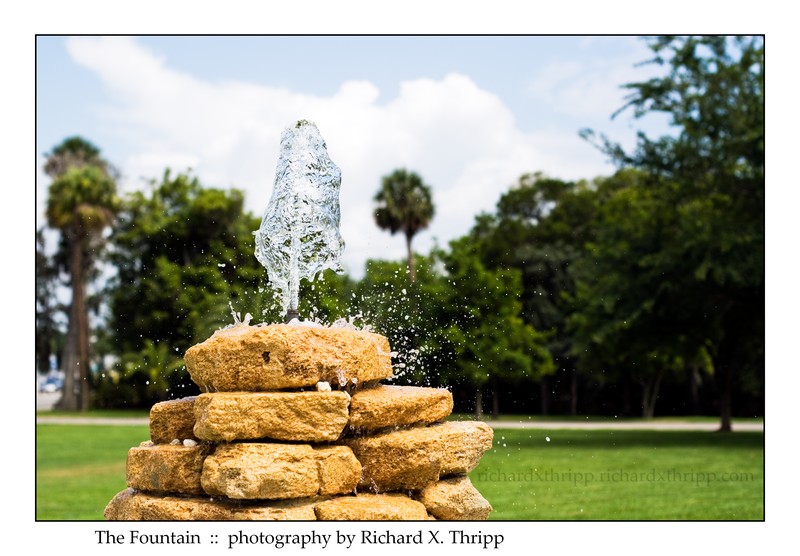
When I started out keywording my images on my deviantART gallery, the only thing I’d be able to think of for this photo is “water” and “fountain.” I’ve since given up keywording (so boring), but if you’re wanting to sell stock, it’s a necessary evil that you will become better at over a long, arduous journey. So what can I think of for this photo now?
water, fountain, wishing, well, wells, wish, droplets, drops, raindrops, raindrop, liquid, park, day, outdoors, splash, splashes, summer, fun, coquina, rock, rocks, pattern, texture, yellow, aqua, clean, clear, fresh, refresh, refreshing, refreshment, cool, cold, clarity, frozen, movement, fast, float, floating, speed, stream, streaming, light, bright, geyser, geiser, gush, gushing, spring, springs, burst, flow, life, wet, h2o, drink, taste, nature, shine, shiny, reflections, spatter, splatter, purity, pure
Yeah, that’s it, spam the heck out of them. Give them so many keywords, there’s no way your image won’t be seen by thousands of people, 1% of which will buy it. It’s the only way to do it.
If you’ve noticed, there is some stuff I left out. I could’ve used these:
tree, trees, forest, forests, sky, cloud, clouds, cloudy, sunshine, sun, bright, blue, skies, white, green, shade, dark, shady, grass, vivid
The reason to leave those keywords out is because they’re all describing background elements; the stuff that’s out-of-focus behind the fountain. It’s of no interest to searchers, because they can’t use the photo for those elements anyway (they’re blurry and obstructed). You never want to keyword like that, even if the off-topic stuff takes up a large section of the photo, because it’s irrelevant and of no use to your customers. Recognizing this and developing keywords, like all things in stock photography, takes time and practice. You can even pay $3 an image to have a person assign photos to your keywords (I also offer this service upon special request  ). However, the point of breaking into stock photography is to make money, not to waste money, so you need to do your keywords yourself, because it’s a skill that will serve you well; I’m using them even in the tags for this blog post (editing, guides, metadata, model releases, passive income, photoshop, stock photography).
). However, the point of breaking into stock photography is to make money, not to waste money, so you need to do your keywords yourself, because it’s a skill that will serve you well; I’m using them even in the tags for this blog post (editing, guides, metadata, model releases, passive income, photoshop, stock photography).
Stock photography is hard work like all else, but if you enjoy it, I can see it becoming painless and rewarding. Plus, it’s nice not to have a traditional job for once. Have fun out there.
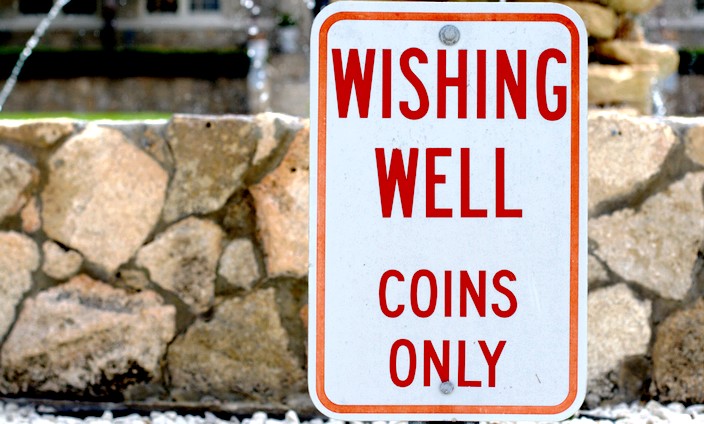
2009-12-20 Update: This article is #1 in Google for “photography sucks,” so I see why it gets so many comments. Don’t take me too seriously. Photography is really an art form and I am playing devil’s advocate here. 
“I wish photography could be an art form. I love it so much, but it’s just too easy. If only there were some way to mentally cripple the majority of the population from being able to take beautiful photos, or if I could make the craft so needlessly difficult to only be accessible to a tiny few. Maybe then I can trick others into thinking I have talent where there is none. Oh photography, why must you be so simple and uncomplicated!”
We’ve been tricked—all of us—into believing that photography is an art form requiring skill, talent, patience, and “the eye,” when outside of fairy land, it requires no more skill or talent than driving a car, or pushing buttons on an elevator. What kind of art form would have these ten traits?
1. Anyone can do it. While we’ve not proven the infinite monkey theorem for reproducing Shakespeare’s Hamlet, surely a monkey could take a good, interesting photo. In fact, with today’s auto-focusing, auto-metering, easy-to-use cameras, I have no doubt that a monkey, with some practice, could take a photo as good as Sunrays or The Red-Brick House. Do you like doing the job of a monkey?
2. No talent involved. You’re in a good place, you take a good picture. You’re in a bad place; you get nothing. It doesn’t matter if you have passion or willpower. If someone else is in the right place at the right time, they can easily capture the moment just as well, even if they’ve been handed a camera for the first time. You can’t say the same about any real art form, like playing the piano, or drawing, or sculpting, which require years of experience and practice.
3. No creativity. When you take a photo, you’re using a tool to save a copy of a scene. You’re creating nothing and the camera’s creating nothing. If the camera does create something, it isn’t art—it’s a defect. The more you protest that your badly-composed, out-of-focus pictures bear your unique artistic sensibilities, the more you satisfy your own delusions. Photography is about as creative as mowing the lawn (and if you think that’s creative, then you have my sympathy).
4. It doesn’t help you to look at the world differently, no more than painting, or sketching, or kayaking, or any other hobby. If anything, your view of the world narrows, because you’re stuck looking at it through your narrow viewfinder.
5. It’s an art that’s not a science, and a science that’s not an art. If my five-year-old sister can cover my job on our vacation to Disney world, then what kind of science is that? Normal scientific processes are torturous and difficult to master, like constructing a high-rise bridge or installing an Olympic-size swimming pool. Scientific arts like performing a complex piano piece or crocheting a beautiful sweater require years of expertise and practice. Not photography. Photography is for dummies. Then on the other end, we have b.s. science touted by the “artists,” like megapixels, lens optics, and sensor reflectivity. They have no idea what this stuff means, nor do they need any understanding of it to take pretty pictures, but they pretend it makes the craft complex, and their jobs, difficult and valuable. Kudos to the engineers, sure, but I’m not scientific as a mere photographer, any more than I’d be an auto mechanic for driving a car.
6. No future. You can’t make money taking pictures. If you do, you’re not an artist, you’re a businessman. Nothing more.
7. Life as a technician. You can’t get a good photo unless you Photoshop the heck out of it, like going from this awful thing to Leafy Droplets 4. Is that creative? My 10-year-old cousin can add some contrast, sharpen, darken the corners, and shift the colors with ease. If you put yourself through hours of this drudgery, you’re no more of an artist than the lab operator at Wal-Mart. A computer can easily replace you. How does it feel wasting your talent?
8. Strokes of luck. If you do capture a great photo that needs no editing, it’s because of reason #3. No talent whatsoever; you were just lucky enough to be in the right place at the right time, and disciplined enough to have your camera ready. So basically, your dependent on fate to bring you pretty pictures to photograph. Don’t you want to be in control of what you create, and when you create it? Do you like doing work that relies on luck, discipline, and drudgery, that you’re not even getting paid for? You may as well be digging ditches. At least then you’d be doing something useful for the world.
9. Join a community of morons. Maybe your smart and join a “camera club.” Then, you get to hear a dozen other people complain about the delay of Nikon’s latest DSLR and make excuses why they can never be a good photographer until they have *insert lens here*. Then they’ll complain about how they can’t attract any money. Maybe if they’d add something real to the world, they’d have the money to buy their toys. If you’re a photographer, you may as well be playing the latest World of Warcraft game.
Or perhaps you’re particularly dedicated and follow your passion to a photography university. Then you get to spend four years and thousands of dollars on the dead art of film, while hearing old codgers whining that the youngsters have it too easy nowadays. You may as well learn Latin. If you want to be a professional photographer, take a business class. But you’re condemning yourself to a lifetime of slave labor. If we had today’s photography before Lincoln’s time, then slaves would be photographing our children’s birthdays and recording our weddings. Why? Because slaves were forced to do tedious, boring, uncreative work.
10. You’re a dime a dozen. You’re building no legacy, you can’t pass your business on to your children, you work on assignment for pennies, and anyone can replace you at anytime. In what other artistic field can anyone do exactly the same work you do, with no talent nor experience? Read rubbish like Is Color Photography an Art? with any spirit of inquiry, and you can see what fools we are.
“Okay, so since photography is really nothing, we’ll give it some class. Only photography done on expensive, time-consuming film is art. No color nonsense—that’s too much like the real world. Digital doesn’t count—it’s missing the needless drudgery. 35mm? Are you crazy? That’s the easy way out.”
Can’t you see how dumb this is? If photography was an art form, we wouldn’t have millions of pages debating the subject. It would be plain and obvious. The very existence of a debate proves that photography as art is shaky ground to stand on. You don’t see anyone debating painting as an art form, or protesting the Mona Lisa as uncreative.
“The color photographer has many means of bringing expression into a scene; the selection of camera position, lens focal length, use of filters, depth of field, film type, exposure, composition, and shutter speed all figure into the image that is produced. During printing, the color photographer has control of contrast, density, color balance, and saturation to convey personal expression.”
Oh puh-lease. “The cashier has many ways of being creative at the check-out line. She can express herself by scanning your groceries swiftly, grouping them by color, double-bagging at her discretion, and suggesting candy bars and periodicals. She has control of the conversation, by making friendly chit-chat or working without delay. Through the artistic medium of words, she has the potential to positively influence hundreds of people every day.”
At least cashiers don’t delude themselves thinking they’re at the pinnacle of artistic expression and can change the world. Perhaps we aren’t so lucky.
Photography is fine for what it is: a pseudo art form for talentless hacks. But don’t give it more respect than it deserves.
After weeks of threatening skies that produced nothing, we’re finally getting some rain in Daytona Beach, Florida (Ormond Beach actually, but they’re close). I was drenched on the way to school yesterday, and we just had quite a cloudburst at my house. Here are two photos:
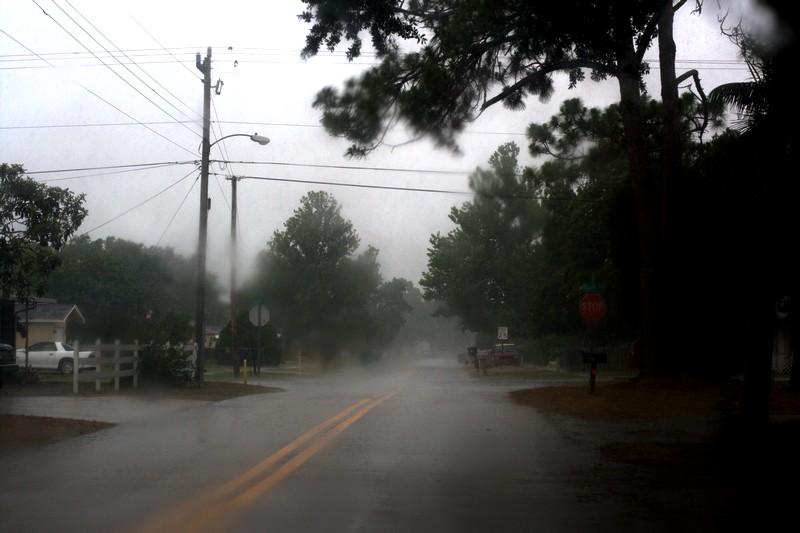
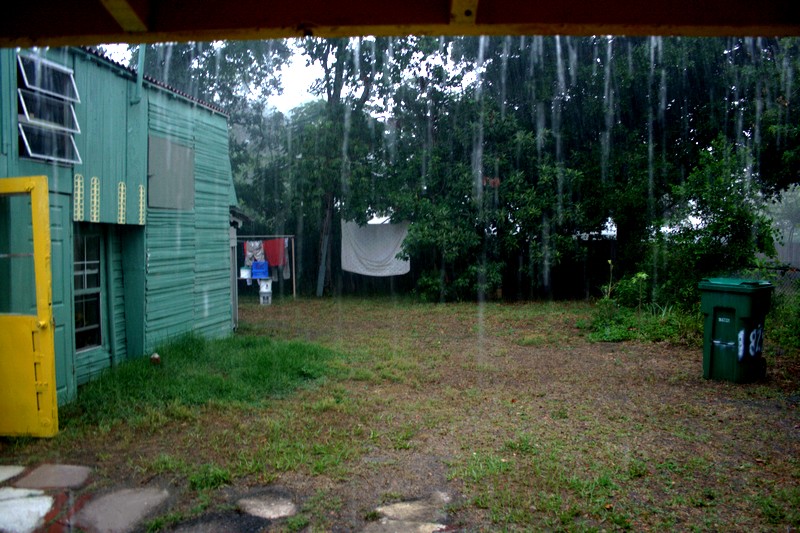
One thing that you’ll find when it’s raining a lot… is that it’s hard to get a good picture! First, it’s very dark out, so motion blur becomes a big problem. Second, you’ll take lots of photos where it looks like nothing is happening! (I always do.) Just a bit of fog or a gloomy sky, instead of the big raindrops and howling winds that your eyes see.
You can only really show the wind with a motion blur shot of trees, or if there’s a tornado or tons of mist flying about. You get photos with no rain because it takes a fast shutter speed to show it, which you can’t use in the dark normally (try upping the ISO sensitivity and using a smaller f number). But I have some other tips to capture the mood:
• Over-ride the auto-metering by stopping down a bit. When you want a dark scene, the camera doesn’t know and will make everything look bright and cheery. You have to fix that yourself.
• Show puddles, big puddles. Or the raindrops hitting those puddles. Use as fast a shutter speed you can, or a slow one showing the blur of turbulent water.
• Get a shot of raindrops falling. This works best if it’s still raining and the sun has come out, because there’s plenty of light and you can easily use a fast shutter speed, like 1/2000 of a second.
• Show raindrops on a window with a dark sky behind it, from inside your house or in the car.
• Stake out a spot and take shots of cars kicking up water, like my shot, Make Waves.
• Take shots before the rain starts, like I did with The Red-Brick House. Often, the sky is beautiful and ominous, but after the rain starts falling, it turns to a boring gray mush.
• Get closer. Even if it’s blurry, snap photos of rain sweeping off roofs or draining from gutters. You’ll capture the experience of torrential rain much better than just pointing your camera into the sky.
• When it’s blue and rainy out, your camera will “fix” this by making it look a normal, warm gray. Over-ride the white balance by using the “sunny” setting (not cloudy, as that’s too warm). You’ll get more interesting, unsettling blue tones, without them being excessive.
• Protect your camera! Put a plastic bag over it, then cut a hole for the lens if you need to. If you’re particularly wealthy, you can even buy a camera rain cover (there are lots of options).
• Go to the river or ocean and take shots of all the rain hitting the blue water, or the haze off in the distance. Watch out for lightning, though.
• If you’re going to photograph lightning, set up a tripod under a roof somewhere, shooting with a thirty second exposure. You’ll need to close down the aperture as far as you can, perhaps even using a filter to keep the light under control during the lengthy exposure. Don’t trust your camera; under-expose your photos. If any lightning does turn up, the camera won’t be expecting it, so the shot will turn into an over-exposed blob if you’re listening to the meter.
Now you know what to do. Just wait for some rain, and get out there.